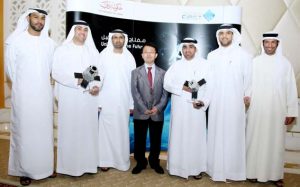
Emirates Institution for Advanced Science and Technology (EIAST) has announced the launch of the new strategic project DubaiSat-3, the first satellite that will be completed in the UAE. A core team of 45 UAE experts and engineers will reportedly lead the development of DubaiSat-3, the third satellite programme to be undertaken by EIAST in collaboration with its partner Satrec Initiative (SI), a solution provider for Earth observation missions.
EIAST will start developing its own clean room and satellite manufacturing facilities, which consist of labs that keep the environment in the clean room free from dust and humidity, at the EIAST headquarters in Dubai, this year, as part of preparations for the transfer of the DubaiSat-3 to Dubai
DubaiSat-3 will initially be developed in South Korea and later transferred to EIAST’s satellite manufacturing facilities in the UAE midway through the project.
EIAST further revealed that it will start developing its own clean room and satellite manufacturing facilities, which consist of labs that keep the environment in the clean room free from dust and humidity, at the EIAST headquarters in Dubai, this year, as part of preparations for the transfer of the DubaiSat-3 to Dubai.
EIAST’s Emirati engineers will reportedly be taking the lead in the development of the project from the start and SI will be assuming a consultative role.
Eng. Salem Al Marri, Assistant Director General for Scientific and Technical Affairs, EIAST, said: “The satellite bus of DubaiSat-3 will be similar to that of DubaiSat-2, but there will be significant changes in its payload and the size of the camera. It will also feature a new, highly sophisticated camera system, which works as an accurate magnifier achieving a sub-metre resolution of 70 centimetres from a distance of 600 kilometres above the surface of the Earth. There will also be improvements in the download speed and computing capabilities,” added Eng. Al Marri.
EIAST has reportedly developed a core team of 45 UAE experts and engineers for the DubaiSat-3 project and its ground systems, and intends to hire additional UAE nationals in later stages of the project, in line with one of EIAST’s main strategic goals; to advance the skills development of Emiratis. The launch of the DubaiSat-3 Project is the culmination of a three-step approach that ultimately aims to achieve full capabilities, knowledge, facilities and research ability to develop advanced satellite missions on UAE soil.
The first step of EIAST’s three-step approach to its satellite systems development focused on the transfer of technology and knowledge with the development of DubaiSat-1, which was developed by Satrec Initiative in South Korea and launched by EIAST in 2009. In step two, EIAST established a core team of UAE experts and engineers to jointly develop DubaiSat-2, which has been scheduled to be sent to orbit in 2013. In step three, EIAST reportedly intends to undertake a more prominent leadership role in the development of the DubaiSat-3 satellite.
EIAST was established by the Dubai Government in 2006 with the goal to promote a culture of advanced scientific research and technology innovation in Dubai and the UAE, and to enhance UAE nationals’ capacity in technological innovation and attaining leading scientific levels. It is mainly involved in outer space research and development; manufacture of satellites and development of systems; space imaging; and ground station services and support to other satellites.












Add Comment